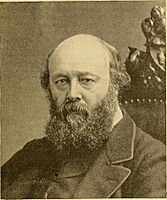Second Salisbury ministry facts for kids
Quick facts for kids Second Salisbury ministry |
|
|---|---|
| 1886–1892 | |

Salisbury (1892)
|
|
| Date formed | 25 July 1886 |
| Date dissolved | 11 August 1892 |
| People and organisations | |
| Monarch | Victoria |
| Prime Minister | Lord Salisbury |
| Total no. of members | 113 appointments |
| Member parties | Conservative Party |
| Status in legislature |
Minority
dependent on Liberal Unionist support |
| Opposition party | Liberal Party |
| Opposition leaders |
|
| History | |
| Election(s) | 1886 general election |
| Outgoing election | 1892 general election |
| Legislature term(s) |
|
| Predecessor | Third Gladstone ministry |
| Successor | Fourth Gladstone ministry |
The government led by Lord Salisbury was in power in the United Kingdom from 1886 to 1892. This was his second time serving as British prime minister. His government was formed after the 1886 general election. It was supported by the Liberal Unionist Party, even though his own Conservative Party did not have a majority of seats in Parliament. This type of government is called a minority government.
Contents
What Was Salisbury's Second Government?
A "ministry" or "government" refers to the group of people, led by the Prime Minister, who run the country. They are chosen from the political party (or parties) that win the most seats in a general election. This particular government was led by Lord Salisbury. He was the Prime Minister and also held the important role of Foreign Secretary for most of this period.
How the Government Was Formed
After the election in 1886, Lord Salisbury was asked by Queen Victoria to become Prime Minister again. His Conservative Party did not win enough seats to govern alone. However, they made an agreement with the Liberal Unionist Party. This party had split from the Liberal Party over a disagreement about Ireland. With their support, Lord Salisbury was able to form a government.
Key People in the Cabinet
The Cabinet is a small group of the most important ministers in the government. They make big decisions for the country. Here are some of the key members of Lord Salisbury's Cabinet:
- Prime Minister and Foreign Secretary: Lord Salisbury himself. He was in charge of the government and also handled relationships with other countries.
- Lord Chancellor: Lord Halsbury. This person is the head of the justice system and a senior member of the government.
- Home Secretary: Henry Matthews. He was responsible for law and order within the UK.
- Chancellor of the Exchequer: This role is like the country's chief financial officer.
- First, Lord Randolph Churchill held this job.
- Later, George Goschen took over. He was a member of the Liberal Unionist Party, showing the alliance between the two parties.
- First Lord of the Treasury: This role is often held by the Prime Minister, but sometimes by another senior minister.
- William Henry Smith held this role for a long time.
- After his death, Arthur Balfour took over.
- Secretary of State for War: Edward Stanhope. He was in charge of the army and military matters.
- Secretary of State for India: Lord Cross. He managed affairs related to British India.
Important Changes Over Time
The government's team changed a few times during its six years in power:
- In February 1888, Sir Michael Hicks Beach became the President of the Board of Trade. This department looked after business and trade.
- In September 1889, Henry Chaplin joined the Cabinet as the President of the Board of Agriculture. This was a new role to help farmers and food production.
- In October 1891, William Henry Smith sadly passed away. Arthur Balfour then took over his important roles as First Lord of the Treasury and Leader of the House of Commons. William Jackson then became the Chief Secretary for Ireland.
The government lasted until 1892, when it lost a vote of confidence in Parliament after the general election. This meant they no longer had enough support to govern, and a new government was formed.

